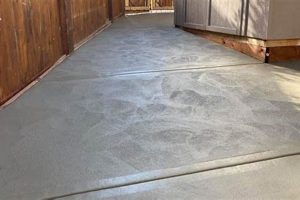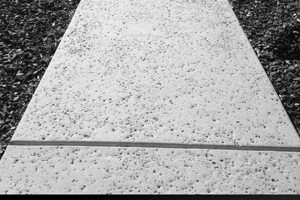This surface treatment method for concrete aims to achieve a smooth, uniform appearance by removing surface imperfections. Typically performed after the concrete has cured sufficiently, the process involves using abrasive tools to eliminate form marks, minor irregularities, and variations in color. The result is a refined surface, free from the coarse texture often associated with untreated concrete.
The implementation of this technique offers several advantages. It enhances the aesthetic appeal of concrete structures, creating a more visually pleasing outcome. Furthermore, it can improve the durability of the concrete surface by eliminating weak points and promoting a denser outer layer. Historically, this technique has been employed in architectural applications to provide a sophisticated and durable finish to walls, columns, and other structural elements.
The subsequent sections will delve into the specific tools and techniques employed in achieving this refined concrete surface, as well as exploring its application in various construction contexts and comparing it to other concrete finishing options.
Achieving Optimal Results
The successful implementation of this concrete surfacing technique requires careful attention to detail and adherence to best practices. The following tips are designed to maximize the quality and longevity of the finished surface.
Tip 1: Surface Preparation: Thoroughly clean the concrete surface before commencing the rubbing process. Remove all debris, loose particles, and contaminants that may interfere with the abrasive action. Pressure washing is often effective for this purpose.
Tip 2: Timing Considerations: Initiate the process when the concrete has reached sufficient hardness, typically after a minimum curing period. However, avoid allowing the concrete to become excessively hard, as this can increase the difficulty of the rubbing operation.
Tip 3: Tool Selection: Choose appropriate abrasive tools based on the desired level of refinement. Options include rubbing bricks, carborundum stones, and diamond grinding pads. Start with coarser grits and progressively move to finer grits to achieve the desired smoothness.
Tip 4: Consistent Application: Apply uniform pressure and maintain a consistent rubbing pattern across the entire surface. Avoid dwelling in one area for an extended period, as this can result in uneven material removal and surface irregularities.
Tip 5: Water Management: Use water to keep the surface and abrasive tools lubricated during the rubbing process. This reduces friction, prevents clogging, and facilitates the removal of debris.
Tip 6: Edge Treatment: Pay close attention to edges and corners. Use specialized tools or techniques to ensure that these areas are properly finished and free from sharp edges or inconsistencies.
Tip 7: Curing After Treatment: After the rubbing process is complete, properly cure the concrete surface to ensure optimal strength and durability. This may involve applying a curing compound or covering the surface with wet burlap.
These guidelines, when diligently followed, can contribute significantly to achieving a high-quality, aesthetically pleasing, and durable outcome. The key lies in meticulous preparation, appropriate tool selection, and consistent execution.
The concluding section will summarize the key benefits of this surface treatment and its role in modern construction practices.
1. Smoothness
The achievement of a smooth surface is a central objective in employing a rubbed concrete treatment. The abrasive process directly aims to eliminate surface irregularities, resulting in a tactilely and visually refined plane. This smoothness is not merely an aesthetic preference; it directly correlates with increased durability and reduced maintenance requirements. For example, a smooth concrete surface resists the accumulation of dirt and grime more effectively than a rough surface, thereby simplifying cleaning and reducing the potential for staining. The absence of sharp edges or protrusions also minimizes the risk of impact damage and chipping, contributing to a longer service life.
The degree of smoothness achieved depends on the specific abrasives used and the duration of the rubbing process. Architectural applications often demand a higher level of smoothness compared to industrial settings, necessitating finer abrasives and more meticulous execution. In public spaces, such as museum floors or building lobbies, a polished, smooth concrete finish enhances the visual appeal and contributes to a sense of sophistication. Conversely, in warehouses or factories, a slightly less refined but still smooth surface is often sufficient to provide durability and ease of cleaning.
In conclusion, smoothness is not simply a desirable attribute of a concrete surface; it is a functional characteristic that contributes significantly to the performance and longevity of the material. The attainment of this smoothness through rubbing necessitates careful material selection, skilled execution, and an understanding of the specific requirements of the application. Properly executed smoothness is a defining characteristic of the treatment, reflecting its intent to enhance both the aesthetic and functional properties of concrete.
2. Uniformity
Achieving visual and textural uniformity is a primary goal when employing surface rubbing on concrete. Variations in color, aggregate distribution, and surface texture detract from the overall aesthetic and can indicate inconsistencies in the underlying concrete or the application process itself. The rubbing technique, through consistent abrasion, aims to mitigate these discrepancies, creating a more homogeneous appearance. This is particularly critical in architectural concrete where large, exposed surfaces demand a high degree of visual harmony. For example, precast concrete panels treated with a rubbed surface often require meticulous attention to uniformity to ensure that each panel seamlessly integrates with the others, resulting in a monolithic appearance. The absence of uniformity can lead to a fragmented and visually unappealing structure.
The degree of uniformity required dictates the tools and techniques used. Achieving a highly uniform surface necessitates precise control over the rubbing pressure, the selection of abrasive materials, and the consistent application of water. Irregularities in the concrete mix itself, such as variations in cement hydration or aggregate segregation, can be difficult to correct solely through surface rubbing. Therefore, careful attention to the concrete mix design and placement techniques is paramount to achieving a uniform starting point. In situations where significant color variations exist within the concrete, staining or pigmenting agents may be used in conjunction with the rubbing process to further enhance uniformity.
In summary, uniformity is an essential characteristic of a properly executed surface treatment. It contributes significantly to the aesthetic appeal and perceived quality of the finished product. While surface rubbing can effectively mitigate minor inconsistencies, achieving true uniformity requires a holistic approach that encompasses careful concrete mix design, precise placement techniques, and skilled application of the rubbing process. The pursuit of uniformity is not merely an aesthetic concern; it is a reflection of the quality control and attention to detail that are hallmarks of superior concrete construction.
3. Durability
A direct correlation exists between a correctly executed concrete surface treatment and enhanced durability. The rubbing process, by removing surface imperfections and creating a denser outer layer, increases the concrete’s resistance to environmental factors and physical damage. Surface irregularities, if left untreated, can serve as points of ingress for moisture, chemicals, and other deleterious substances. These substances can then initiate internal degradation processes, such as freeze-thaw damage, alkali-silica reaction, and corrosion of reinforcing steel. By eliminating these potential entry points, the surface treatment effectively prolongs the concrete’s service life. A real-world example is the treatment of bridge piers. A properly prepared and treated surface resists the constant exposure to water and de-icing salts, significantly reducing the rate of deterioration compared to untreated piers.
The contribution to durability is not limited to preventing ingress of harmful substances. The abrasive action of the rubbing process also strengthens the concrete surface. Minor surface cracks and micro-fractures, which are common in newly placed concrete, are removed during the rubbing process. This eliminates potential weak points that could propagate under stress or impact. Furthermore, the rubbing action compacts the surface, increasing its density and resistance to abrasion. This is particularly important in high-traffic areas, such as industrial floors or sidewalks, where the concrete is subjected to constant wear and tear. Proper maintenance, including periodic cleaning and sealing, can further enhance the durability of a treated concrete surface.
In conclusion, enhanced durability is a significant benefit derived from concrete surface treatment. The treatment’s ability to eliminate surface imperfections, create a denser outer layer, and prevent the ingress of harmful substances contributes directly to a longer service life and reduced maintenance costs. While the initial investment in the treatment may be higher compared to leaving the concrete untreated, the long-term benefits in terms of durability and reduced repair needs typically outweigh the upfront costs. The importance of surface preparation and proper execution of the rubbing process cannot be overstated, as these factors directly influence the extent to which the durability of the concrete is enhanced.
4. Aesthetics
The application of a surface treatment on concrete significantly impacts its aesthetic qualities. The resultant surface, whether intended for functional or decorative purposes, inherently alters the visual perception of the material. The following facets delineate key aesthetic components affected by the technique.
- Color Consistency
Surface rubbing can even out variations in color that may occur due to inconsistent hydration or aggregate distribution during the initial pour. This results in a more uniform and visually appealing surface, particularly crucial in large, exposed areas where color disparities are readily apparent. An example is precast concrete panels; consistent color ensures seamless integration within a building’s facade.
- Surface Texture Refinement
The process fundamentally alters the concrete’s texture. By removing imperfections and creating a smoother plane, the treatment eliminates the rough, industrial appearance often associated with untreated concrete. This textural refinement allows the material to be utilized in more sophisticated architectural applications, such as interior walls or decorative features where a refined tactile experience is desired.
- Light Reflectivity Control
The degree of surface treatment affects light reflectivity. A highly polished surface will reflect light more intensely, creating a brighter and more open atmosphere. Conversely, a less refined surface will diffuse light, resulting in a softer and more subdued ambiance. This control over light reflectivity allows architects and designers to tailor the visual effect of concrete to suit the specific requirements of a space. For instance, a museum may opt for a low-reflectivity surface to minimize glare and distractions, while a retail space may choose a higher reflectivity to enhance brightness and visual interest.
- Form and Detail Emphasis
By creating a clean and uniform surface, the treatment enhances the visibility of the concrete’s form and any incorporated details. Architectural features, such as reveals, chamfers, or embedded aggregates, are more readily apparent and visually impactful when set against a smooth, consistent background. This allows for a greater level of design expression and facilitates the creation of visually striking concrete elements.
These aesthetic components, collectively influenced by the concrete surface treatment, demonstrate the technique’s ability to transform a purely functional material into a visually compelling element. The selection of the appropriate surface treatment method is thus a critical design decision, directly impacting the overall aesthetic character of the structure.
5. Maintenance
The long-term performance and aesthetic appeal of a surface rely heavily on appropriate maintenance practices. A properly executed concrete surface offers significant advantages in terms of reduced upkeep and enhanced durability. Understanding the specific maintenance requirements associated with this finish is crucial for maximizing its lifespan and preserving its intended appearance.
- Ease of Cleaning
The smoothness inherent to a correctly executed surface simplifies routine cleaning. The absence of significant surface irregularities prevents the accumulation of dirt, dust, and debris, reducing the effort required to maintain a clean surface. Regular sweeping or vacuuming, combined with occasional damp mopping using a neutral pH cleaner, is often sufficient to preserve the appearance of the finish. This contrasts sharply with untreated concrete, which tends to be more porous and difficult to clean effectively.
- Stain Resistance
While not entirely impervious to staining, a concrete surface exhibits enhanced resistance compared to untreated concrete. The denser surface reduces the absorption of liquids, providing a window of opportunity to clean spills before they penetrate and cause permanent discoloration. Prompt removal of spills, particularly those involving oil, grease, or acidic substances, is essential for minimizing the risk of staining. The application of a protective sealant can further enhance stain resistance.
- Sealer Application and Reapplication
The application of a penetrating or film-forming sealer is a common practice to protect a finished concrete surface. Sealers enhance stain resistance, reduce water absorption, and improve the abrasion resistance of the surface. The type of sealer used should be carefully selected based on the intended use of the concrete and the environmental conditions to which it will be exposed. Periodic reapplication of the sealer is necessary to maintain its protective properties. The frequency of reapplication depends on the type of sealer used and the level of traffic or exposure the surface experiences.
- Repair of Minor Damage
Despite its enhanced durability, a finished concrete surface can still be susceptible to minor damage, such as chips, cracks, or scratches. Prompt repair of such damage is essential to prevent further deterioration and maintain the aesthetic appearance of the finish. Small chips and cracks can be repaired using epoxy-based patching compounds. Larger repairs may require the removal and replacement of damaged sections of concrete. Proper surface preparation and application techniques are critical for ensuring a durable and aesthetically pleasing repair.
In conclusion, maintenance is an integral aspect of maximizing the benefits of a surface. While this finish offers inherent advantages in terms of reduced upkeep, adherence to proper maintenance practices is crucial for preserving its long-term performance and aesthetic appeal. Regular cleaning, prompt spill removal, periodic sealer reapplication, and timely repair of minor damage are all essential components of a comprehensive maintenance program.
Frequently Asked Questions Regarding Concrete Surface Treatment
The following section addresses common inquiries and clarifies prevalent misconceptions surrounding concrete surface treatments, specifically those involving abrasive techniques.
Question 1: Is surface treatment applicable to all types of concrete?
The applicability of surface treatment is contingent on the concrete’s composition, age, and structural integrity. Concrete with excessive cracking, significant delamination, or inadequate compressive strength may not be suitable. A thorough assessment by a qualified professional is recommended prior to commencing any treatment.
Question 2: What is the expected lifespan of a concrete surface?
The lifespan of a surface is influenced by factors such as the quality of the initial concrete, the thoroughness of the surface treatment, environmental exposure, and maintenance practices. With proper execution and consistent maintenance, a surface can exhibit a service life comparable to, or even exceeding, that of untreated concrete.
Question 3: Does surface treatment affect the structural integrity of concrete?
When performed correctly, surface treatment should not compromise the structural integrity of the concrete. The abrasive process removes only a thin layer of surface material and does not affect the underlying structural components. However, excessive material removal or improper techniques can potentially weaken the concrete surface. It is crucial to adhere to established best practices and employ qualified personnel.
Question 4: Is a surface treatment process environmentally friendly?
The environmental impact of a surface treatment process depends on the specific techniques employed and the disposal of waste materials. The use of water during the rubbing process generates slurry, which requires proper collection and disposal to prevent environmental contamination. Furthermore, the energy consumption associated with the abrasive equipment and the transportation of materials should be considered. Selecting environmentally responsible materials and adhering to proper waste management practices can minimize the environmental footprint of the process.
Question 5: How does the cost of surface treatment compare to other concrete finishing options?
The cost of surface treatment can vary depending on the size of the area, the complexity of the project, the specific techniques employed, and the labor rates in the region. Generally, surface treatment is more labor-intensive than some other finishing options, such as troweling or brooming, but it can offer superior aesthetic and durability benefits. A detailed cost-benefit analysis should be conducted to determine the most appropriate finishing option for a given project.
Question 6: Can surface treatment be applied to existing concrete surfaces?
Surface treatment can indeed be applied to existing concrete surfaces, provided that the concrete is structurally sound and properly prepared. Existing coatings, sealants, or contaminants must be removed prior to commencing the abrasive process. A test area should be treated to assess the suitability of the concrete and to determine the optimal techniques for achieving the desired results.
Surface treatment, when properly executed, provides a durable and aesthetically pleasing solution for concrete surfaces. A clear understanding of the process, its limitations, and its maintenance requirements is crucial for achieving optimal results.
The subsequent section will delve into case studies showcasing successful applications of concrete surface treatment in various construction projects.
Conclusion
This exploration has detailed the process of achieving a surface, outlining its benefits, application techniques, and maintenance requirements. The technique refines concrete surfaces, enhancing both aesthetic appeal and durability. Successful implementation requires meticulous surface preparation, appropriate tool selection, and consistent execution, ensuring the desired level of smoothness and uniformity is attained. When executed properly, it presents a compelling option for projects demanding enhanced visual characteristics and long-term performance from concrete elements.
The value of a well-executed treatment extends beyond mere aesthetics, contributing to the longevity and sustainability of concrete structures. Further research into innovative abrasive materials and techniques may lead to even more efficient and environmentally responsible methods. Continued adherence to established best practices will ensure that it remains a viable and valuable solution for a wide range of construction applications, solidifying its role in modern construction practices.







